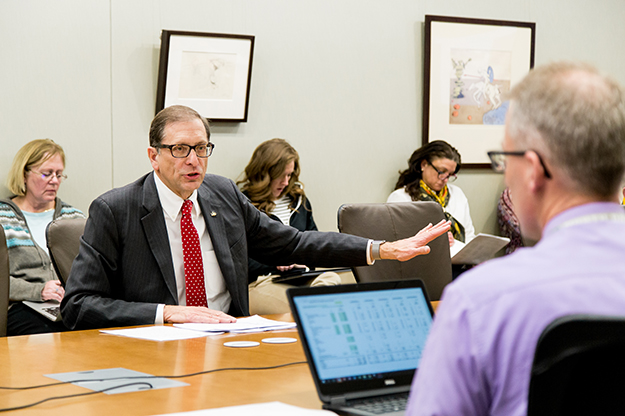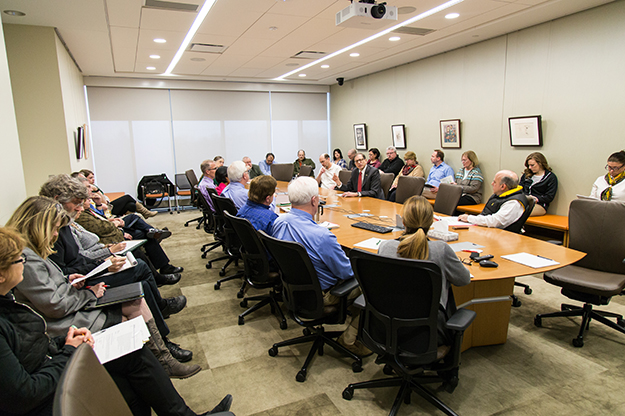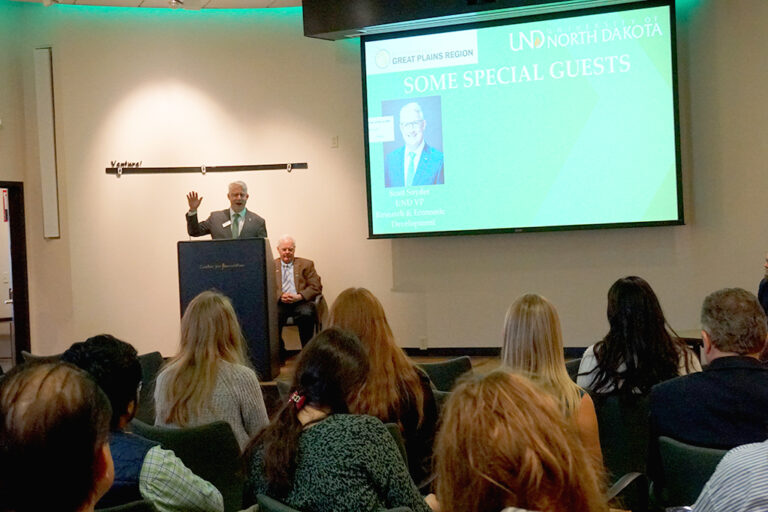Menu of options
UND School of Medicine & Health Sciences releases possible budget cuts

A menu of budget options: that’s how Joshua Wynne described possible budget cuts at a special meeting of the Faculty Academic Council at the School of Medicine & Health Sciences March 23.
Wynne, UND vice president for health affairs and dean of the School, discussed possible budget reductions and sought input from the Faculty Academic Council, which is made up of associate deans, chairs, and faculty.
“What are the budget options we could invoke?” Wynne said. “We know we will have to cut, but we don’t know the extent yet.”
The School has prepared a 90 percent budget for the upcoming biennium, totaling about $4.9 million in cuts. The School is funded separately from UND, and its budget is submitted through UND to the North Dakota University System and then to the Legislature.
“There are three unknowns for the upcoming biennium,” Wynne said. “The actual amount of appropriated funding, how many people will sign approved voluntary separation agreements, and how much tuition will need to increase.”
He said those questions should be answered by around May 1. “Then we can go back to the menu of budget cut options and see which options to choose,” Wynne said. “We will do what makes sense.”
Wynne said that all departments and units in the School gathered input from faculty and staff during the preparation of their proposed budget cuts.
By the numbers
Terry Nelson, associate director of Administration and Finance for the School, attended department and unit meetings as they determined how to meet budget reduction goals, then combined and summarized the budget reduction options for the School.
“The largest amount of reduction relates to voluntary separations and efficiencies,” Wynne said. “The reductions in force and involuntary separations were kept to a minimum.”
Proposed faculty position cuts at the School include 3.26 voluntary separations, one of which would be replaced at a lower salary, and 3.22 unfilled positions. Staff position cuts include 7.10 voluntary separations, three of which would be replaced at a lower salary, and 5.79 unfilled positions. Funding changes, such as using non-appropriated funds, would affect 2.53 staff and 3.32 faculty positions. Operations would be reduced by $1.25 million, mostly through efficiencies. Nelson said efficiencies include residency recruiting, conferences and meetings, travel, and other items.
Proposed cuts for units are $844,555 for biomedical sciences, $1,861,181 for clinical departments, $712,900 for education, $927,900 for health sciences, and $562,997 for the School’s administrative and other departments, including student affairs and admissions, Indians into Medicine (INMED), alumni and community relations, Center for Rural Health, Child Evaluation and Treatment Program, and the Center for Health Promotion & Prevention Research. Some units proposed cuts that exceeded the 10 percent target.
Clinical cuts were targeted at 10 percent. When Nelson was asked how much payments to hospitals and physicians who teach medical students and residents would be reduced, he responded that he did not have that level of detail available, but the reduction proposals had been made by the clinical departments themselves.
The medical library will cut an electronic journal service. Wynne added that electronic journal subscription costs have been rising around 8 to 10 percent per year. “This is unsustainable, not only for our medical library but also for all libraries” he said. “It’s a built-in destabilizer of educational budgets.” Wynne said it would have to be addressed in the long term.
In response to a question from Tom Mohr, associate dean for health sciences, Wynne said that certain pool positions, which are non-benefited, could be consolidated. “We identified efficiencies and some resources that could be consolidated to save money.” These are true efficiencies, he said. “It’s good business management, and we should continue to do this.”
Questions from Legislature
Wynne said that following legislative testimony before the House, the School provided answers to three additional questions: What is a residency? Where are the newly approved residencies located? How does the School use philanthropic donations? He explained that the new residencies emphasize primary care and utilize rural hospitals throughout the state, and donations are focused on reducing student debt.
“Thanks to donors, we have gone from the 75th percentile in medical student debt to the 33rd percentile,” Wynne said, adding that high debt can be a barrier to rural practice because of lower pay.
Wynne said some legislators have asked why the state needs more medical residencies. Besides residencies increasing the number of physicians who are more likely to practice in rural communities and throughout the state, “it has been estimated that every doctor who goes into practice generates about $2.25 million in economic activity per year,” Wynne said. “If we graduate 10 residents who stay in the state, that’s nearly $250 million—almost a quarter of a billion dollars—over a decade. The cost to educate residents is about $7 million—that’s more than a 30-fold return over 10 years, and a pretty good return on investment.”
The Governor’s Executive Budget has also cut one-time funding, which paid for a large portion of the Healthcare Workforce Initiative, a successful program that is increasing the number of physicians and other health professionals working in the state.
Total support from the state is about a third of the School’s budget. “Not many medical schools have this level of government support,” said Mary Ann Sens, professor and chair of pathology. “We have some of the best support in the nation.”
Wynne seconded that by saying “The Legislature understands the importance of the School, and has upped the ante with the Healthcare Workforce Initiative. “We, in turn, generate $2 or more for every dollar the Legislature has invested.”

Tuition in check
Wynne said he wants to do as much as possible to minimize tuition increases and thus keep student debt low, as well as to continue to fully implement the Healthcare Workforce Initiative.
“It’s going to take a lot of pressure for me to recommend a tuition increase of more than 2.5 percent,” Wynne said in response to a question. “I don’t want to put the burden of balancing the budget on the backs of students, and I’d like to keep student debt as low as I can. I take that responsibility seriously.”
Cross-campus budgets
One faculty member asked about the MIRA budget process and the possibility of requesting additional funding from UND after it is implemented. John Shabb, associate professor of biomedical sciences, explained how the Model for Incentive-based Resource Allocation (MIRA) process will work, and said it will not be implemented this year.
“The School is not inclined to request more money at present from the central campus to support, for example, undergraduate education,” said Wynne, who added that the School’s budget target is less than the rest of campus, and that has not gone without comment.
“UND is suffering greater financial impact than the School from the proposed legislation,” Wynne said, with up to 12 percent reductions possible at UND. Also, the main campus covered last year’s allotment budget reduction to allow construction of the new School of Medicine & Health Sciences building to continue unimpeded. “We have a moral obligation to the University to ensure that UND is held whole in this regard.
“Whatever we do,” Wynne said, “we will not deviate from our mission. We will deliver on our commitment to educate, discover new knowledge, and serve the people of North Dakota in the least disruptive way possible given the budget realities.”


